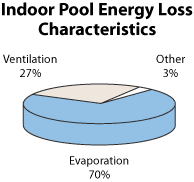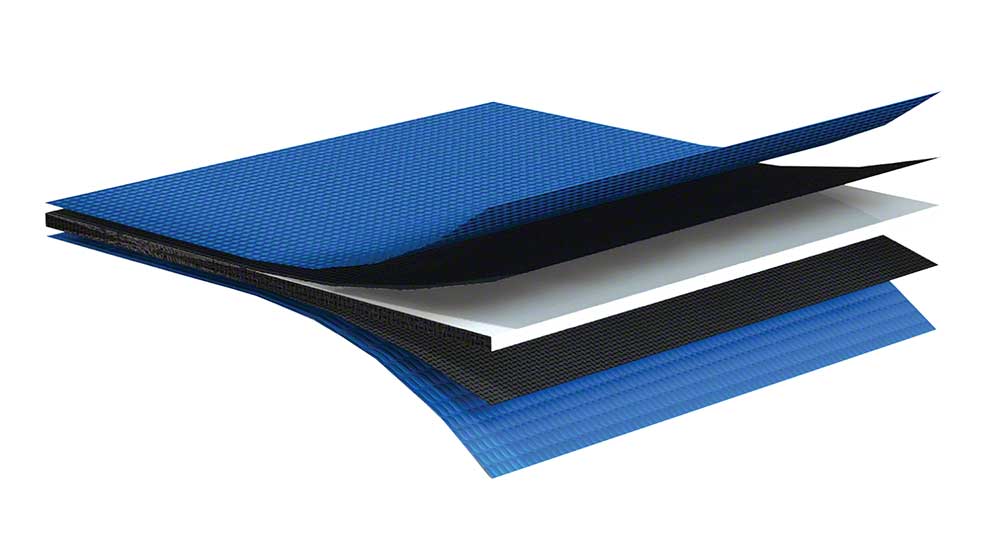HOW THEY WORK
Swimming pools lose energy in a variety of ways, but evaporation is by far the largest source of energy loss. Evaporating water requires tremendous amounts of energy. It only takes 1 Btu (British thermal unit) to raise 1 pound of water 1 degree, but each pound of 80ºF water that evaporates takes a whopping 1,048 Btu of heat out of the pool.
The evaporation rate from an outdoor pool varies depending on the pool's temperature, air temperature and humidity, and the wind speed at the pool surface. The higher the pool temperature and wind speed and the lower the humidity, the greater the evaporation rate. In windy areas, you can add a windbreak—trees, shrubs, or a fence—to reduce evaporation. The windbreak needs to be high enough and close enough to the pool that it doesn't create turbulence over the pool, which will increase evaporation. You also don't want the windbreak to shade the pool from the sun, which helps heat it.

Indoor pools aren't subjected to the environment, but they still can lose a lot of energy from evaporation. They even require room ventilation to control indoor humidity caused by the large amount of evaporation. The ventilated air also must be conditioned, which adds to the energy costs.
Pool covers minimize evaporation from both outdoor and indoor pools. Covering a pool when it is not in use is the single most effective means of reducing pool heating costs. Savings of 50%–70% are possible.
Pool covers on indoor pools not only can reduce evaporation but also the need to ventilate indoor air and replace it with unconditioned outdoor air. You can also shut off exhaust fans when an indoor pool is covered, which saves even more energy.
TYPES OF POOL COVERS
Technically, all you really need for a pool cover is a large sheet of plastic. Plastic meets the requirement of being a vapor barrier. But a large sheet of plastic that you get from the lumber store is probably not your best choice. It will be very difficult to handle and store, it tears easily, and sunlight will deteriorate it rapidly. You can use a sheet of plastic, but it will be very inconvenient and it will probably only last 1 to 2 seasons maximum.

THERMAL BLANKET COVER
A high insulation material that completely saves evaporation, reduces considerably the humidity in internal pools, saves energy and minimizes the use of chemicals.
The cover is very light and easy to use. The reel is equipped with wheels to be removed if desired.
It's best to use a cover designed specifically for swimming pools.
They're made of special materials, such as UV-stabilized polyethylene, polypropylene, or vinyl. They can be transparent or opaque.
Covers can even be light or dark colored.
One of the lowest cost covers made specifically for swimming pools is the bubble (or solar) cover.
Bubble covers are similar to bubble packing material except they use a thicker grade of plastic and have UV inhibitors.
VINYL COVERS
Consist of a heavier material and have a longer life expectancy than bubble covers. Insulated vinyl covers are also available with a thin layer of flexible insulation sandwiched between two layers of vinyl.
Outdoor pools gain heat from the sun, absorbing 75%–85% of the solar energy striking the pool surface. This is an important contribution to the pool's heating needs. A pool cover will decrease the solar gain contribution to some extent, depending on what type you use. A transparent bubble cover may reduce pool solar energy absorption by 5%–15%. A completely opaque cover will reduce it by 20%–40%. You need to consider this when selecting a pool cover.
You also need to decide whether you want a manual, semi-automatic, or an automatic pool cover. You can manually pull the cover on and off, fold it, and place it somewhere out of the way. You can also purchase a pool cover reel to help manually roll up the pool cover. The reel, usually on wheels, can be rolled out of the way.
Semi-automatic covers use a motor-driven reel system. They use electrical power to roll and unroll the cover, but usually require someone to pull on the cover when unrolling, or guide the cover onto the reel when rolling up the cover. Semi-automatic covers can be built into the pool deck surrounding the pool, or can use reels on carts.
Automatic covers have permanently mounted reels that automatically cover and uncover the pool at the push of a button. They're the most expensive option, but they're also the most convenient.
Some pool covers fit into tracks along the sides of the pool. This prevents anything or anybody from getting into the pool. They even support the weight of several people. If liability is a concern, these are a good option to explore. They can be run manually, semi-automatically, or automatically. Safety covers are recommended for public pools, and may be required by inspectors.
HOW TO USE A POOL COVER
Covers should be used during your swimming season.
If you use your pool during the daytime, take off the cover just before swimming and replace the cover as soon as you're done using the pool. If you use your pool only at night, the effectiveness of a pool cover will depend on whether the evaporation and other losses prevented by the cover exceed the solar gain reduction caused by the cover. The type of cover and the climate affects this balance. In dry and/or windy conditions, the evaporation rate of the pool increases. Therefore, it is generally beneficial to have a transparent or bubble cover on during daylight hours. In warm, humid conditions the evaporation rate decreases. In this case, it may be more beneficial to leave the cover off during the daytime.
OTHER POOL COVER BENEFITS
Besides offering energy savings, pool covers also do the following:
- Conserve water by reducing the amount of make-up water needed by 30%–50%
- Reduce cleaning time by keeping dirt and other debris out of the pool
- Reduce the pool's chemical consumption by 35%–60%
Contact us and get a free consultation today
